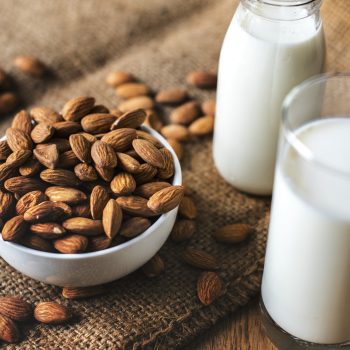 Over the past few years, there has been a massive increase in the number of non-dairy milks available on the market, as interest in dairy free diets has grown substantially. Whilst this means more choice for consumers, it can also lead to confusion over which is the best type of milk for you and your family, in terms of taste, price and of course, nutrition.
Over the past few years, there has been a massive increase in the number of non-dairy milks available on the market, as interest in dairy free diets has grown substantially. Whilst this means more choice for consumers, it can also lead to confusion over which is the best type of milk for you and your family, in terms of taste, price and of course, nutrition.
There are many reasons individuals adopt a dairy or milk-free diet and some of the ones we see most commonly in clinic include dairy allergy, lactose intolerance, veganism, paleo diets, various autoimmune diseases and/or taste preferences. Exploring the various reasons for dairy-free diets is a topic in and of itself, so rather, in this article today, we’ll be examining some of the pros and cons of the different plant ‘milks’ available on the market, to help those already on dairy-free diets decide which might be right for them.
Soy Milk
Soy milk is a hotly contested topic and one that deserves a blog post all on it’s own. Whilst soy has been shown to be beneficial for certain people and health conditions, in general, we recommend being mindful of one’s overall soy consumption, because with all the different forms soy comes in (think tofu, tempeh, soy milk, edamame etc), soy consumption can easily creep up! For the purposes of this article though, we’ll look at soy simply in terms of its use as a milk substitute.
Soy milk is perhaps the most widely available non-dairy milk, which can make it a useful option when dining out or travelling in areas with limited non-dairy options. Compared to most non-dairy milks, soy milk tends to be slightly higher in protein and fat, and has a similar ‘mouth-feel’ and consistency to cow’s milk, meaning it makes a useful milk substitute for things like tea and coffee. When choosing soy milk, we recommend choosing an unsweetened variety without flavouring agents, stabilisers or vegetable oils. For those on gluten free diets, bear in mind that some brands of soy milk contain barley flour or barley malt syrup, so if this is a concern for you, always check the ingredients or look for a gluten-free certification.
Almond Milk
Whilst almonds are undoubtedly a very nutritious food (rich in nutrients like calcium, vitamin E and magnesium), many almond milks contain few almonds to begin with! A quick scan of the ingredients list will often reveal an almond content of around 2-3%, with the rest of the ingredients list made up of things like cane sugar, gellan, tapioca starch and ‘natural’ flavour. If opting for almond milk, try to choose a brand with fewer (or no) ‘additive’ ingredients like stabilisers and flavours.
One option available at most supermarkets is the Pure Harvest Unsweetened Activated Almond Milk, which contains filtered water, organic activated almonds (7%), organic brown rice, sea salt and almond essence. In terms of almond content, the Pure Harvest Activated Almond Milk is a winner with 10% almonds, but it does contain a small amount of rice syrup if you are concerned about sugar content. At smaller grocers, there’s often a variety of almond milk brands kept in the fridge section as well – many of these have simple ingredients lists, made up of things like water, almonds, sea salt and vanilla. Some cafes even make their own almond milks, which can also be a great option.
Coconut Milk
Coconut milk has certainly increased in popularity in the last 5-6 years, especially with the rise of the paleo and grain-free movements! Coconut milk typically has a sweetish, coco-nutty taste, and is noticeably higher in fat than other non-dairy milks, such as oat or rice milk. This can give it a richer mouth feel, which may or may not be to your liking. It also contains less protein than cow’s milk or soy milk.
It’s important to note there’s a difference between canned coconut milk (which is typically 60-90% coconut flesh) and ‘drinking’ coconut milk, which is lower in coconut content and is found in the long-life/UHT milk aisle. Many of our patients enjoy the flavour of coconut milk in their smoothies, muesli or porridge, but bear in mind it will have a more noticeable flavour if added to things like tea or coffee.
One of our favourite options for a non-dairy milk is the Pure Harvest Coco Quench, which is a blend of coconut and rice milk. The coconut content keeps it sweet and creamy, but the blend helps ensure a slightly less rich consistency. It doesn’t contain any flavouring agents or stabilisers, so make sure to give it a good shake before using.
Oat Milk
Oat milk is another option that is relatively easy to find at most supermarkets, although there are fewer options available compared to things like soy and almond milk. Oat milk has a mild, slightly sweet flavour, but typically feels ‘thinner’ than soy or cow’s milk. It is also lower in fat and protein. Whilst there are some organic brands of oat milk, most varieties appear to contain vegetable oils. Most cafes don’t seem to carry oat milk, possibly due to the fact it doesn’t froth up as well as other non-dairy milks, like soy or almond milk.
Rice Milk
Rice milk is the last widely available non-dairy milk on our list, being available in most supermarkets and some cafes. Rice milk is lower in protein and fat than many of the other milks on this list, but is also less allergenic, meaning it can be a good option for individuals with multiple allergies (such as nut, soy and dairy allergies). Rice milk is also quite popular with children, as it is quite sweet and has a relatively smooth mouth-feel. As it has a relatively mild flavour, it can also be useful in baking. When choosing a rice milk, look out for a variety without thickeners, stabilisers or vegetable oils. If regularly consuming rice milk, I’d recommend reading our article about arsenic contamination in rice here, so you can learn how to manage your overall rice intake.
Other Alternatives
There are many other non-dairy milks available on the market, although they are less widely available than those discussed above. These include:
- Cashew milk
- Quinoa milk
- Macadamia milk
- Hazelnut milk
- Hemp seed milk
Factors like taste, cost and ingredients vary widely with these options, so its best to consider them with reference to your own personal circumstances and preferences, if you’re looking to try a new milk alternative.
Another fantastic option is to make your own Cashew Milk, using our recipe here. This allows you to be totally in charge of the ingredients and taste of the milk. Homemade cashew milk is a delicious and nutritious non-dairy option, and unlike many other nut milks, it doesn’t need to be strained. Homemade almond milk is also a great option, but most recipes require a nut milk bag to strain the almond sediment.
Ingredients to Avoid
In general, there are a few key ingredients in non-dairy milks that we recommend avoiding or minimising. These include:
- Vegetable oils (vegetable oils like canola and sunflower oil are generally low-quality and highly refined, and can have pro-inflammatory effects in the body)
- Emulsifiers (e.g. carrageenan, guar gum, xanthan gum etc)
- Artificial sweeteners (e.g. aspartame, saccharin, sucralose)
- Sugar and sugar substitutes (e.g. cane sugar, evaporated cane juice, rice malt syrup, corn syrup etc)
- Flavouring
The Takeaway Message
I hope this has been a helpful guide for those of you interested in exploring the various non-dairy ‘milk’ alternatives available at your local supermarket. Importantly, whilst non-dairy ‘milks’ can be a useful substitute for those avoiding dairy, they should not be relied upon as a source of nutrition. What we mean by this is in terms of nutrition, non-dairy milks should be thought of and used somewhat like a condiment, rather than relied up as a significant source of any particular nutrient. This is particularly important for children on dairy-free diets, as non-dairy ‘milks’ are not a direct nutritional substitute for cow’s milk. If you are on a dairy-free diet and are concerned about nutrients like protein and calcium, make sure to discuss these concerns with your naturopath or healthcare practitioner at your next appointment.

